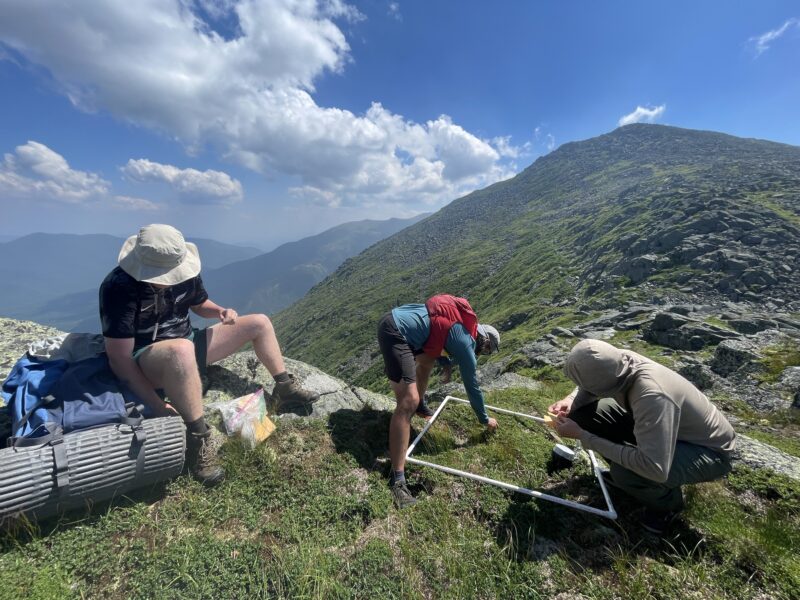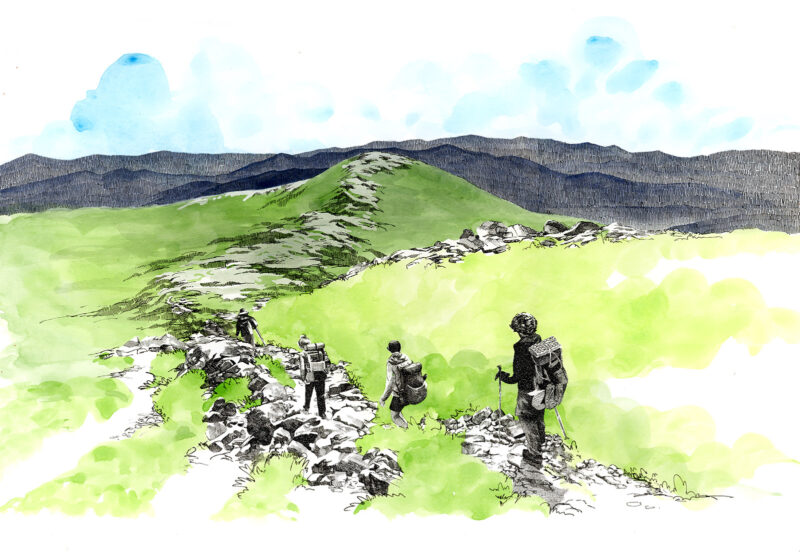Collaborative Research of White Mountain Climatology
Organizations Transform Data into Understanding in New White Mountains Almanac
By Ellen Estabrook
November marked the release of The White Mountains Almanac, a first-of-its-kind publication created by Mount Washington Observatory and partners at the Appalachian Mountain Club (AMC) and Hubbard Brook Research Foundation (HBRF). With funding support from the Cabot Family Charitable Trust, The Nature Conservancy of New Hampshire, Stephen Walker and Diane DeLuca, and the Hartford Foundation for Public Giving, this richly-illustrated almanac offers a comprehensive, year-in-review exploration of ecological and climatological changes observed in the White Mountains region, serving as both a valuable resource for researchers and a compelling guide for nature enthusiasts, educators, and policymakers, as well as the general public.
With contributions from local scientists, naturalists, and community supporters, graduate student Frank Vazzano compiled the data and authored the work during his five-month internship with the three partner nonprofits. The Almanac, he shares, will introduce the reader “to the climatological character of these wonderful mountains, how and where it is changing, and how these changes interact with spheres ranging from ecology to economy, and severe weather to outdoor recreation.”
Twelve chapters (one for each month of the year) feature vivid illustrations, data visualizations, and field observations, documenting the intricate relationships among weather, recreation, wilderness, and the landscape over time, providing a unique look at the region’s evolving climate, ecology, and natural beauty.

AMC researchers conduct a survey of the alpine plant species diversity in a designated 1x1m plot while also collecting leaf tissue to assess leaf traits and to extract DNA for genetic analyses. Photo courtesy AMC
Not only is this the first publication of its kind, but it is also the first syndication of data from three of the region’s historical environmental institutions to enable broader and deeper insights. The project also created the first year of a new joint internship program between the partners. Vazzano, who joined the internship in winter 2025 and wrote the Almanac in the spring, reflected on this experience:
“Having the opportunity to be a trailblazer for the joint almanac internship is something that I will always cherish, and I hope future interns understand how unique and excellent an experience it is to have the input and mentoring of three separate organizations. The knowledge that each organization and contributing member brought to the table was invaluable to the production of the Almanac. This is the most inspiring aspect of the project for me since it illustrates that the Almanac was far from a sole endeavor: it is the culmination of hundreds of hours of work from many talented scientists, communicators, editors, and artists.”

Frank Vazzano on the summit of Mount Washington.
Now pursuing an M.S. in Atmospheric Science as a research assistant at the University of Oklahoma, Vazzano hopes that people from all walks of life “can take away a few high-level conclusions about how the climate and ecology spheres around them are changing. The purpose of the almanac is simply to inform using data and logic (rather than persuade), and to allow the reader to come to their own conclusions whenever possible.”
In using this applicable knowledge, he also hopes takeaways from the text are empowering rather than discouraging: “While the changes we are seeing are serious and will have wide-ranging consequences that will be hard to predict, for now the White Mountains we know and love are not going anywhere,” Vazzano shares. “As the old adage goes, be prepared, not scared! That is, since the future is uncertain, enjoy the moment and the mountains as they are because they might not always be this way.”
Data from three study sites (the Mount Washington Observatory at 6,288’, AMC’s Pinkham Notch Visitor Center at 2,032’, and the Hubbard Brook Experimental Forest at 825’) was compiled (in addition to North Conway’s cooperative weather station in some highlights). The data used in the studies dates back to 1935 for MWOBS and the AMC and 1957 for Hubbard Brook and North Conway, providing a robust period of record for research. Along with the monthly themes highlighted above, the Almanac also features an appendix of Averages and Extremes for temperature, precipitation, snowfall/snow depth, and wind across locations.
A snapshot of the findings shows a significant decline in chilling degree days (45 degrees and below) across all sites since the 1940’s– Northern New Hampshire is losing the cold, and even our coldest mountain peaks are losing winter dormancy conditions, essential to the phenological processes of organisms like alpine plants. AMC’s plant research, begun in 2004 under the name Mountain Watch, is now a partnership called Northeast Alpine Flower Watch, with an aim to track changes in plant phenology as the climate changes.
In analyzing snow trends at Hubbard Brook and Pinkham notch in the months of October through December, results showed a gradually decreasing trend in snow before December 31 in the past few decades, indicating changing winter weather patterns. Research from the project partners also indicates that the overall number of snow days below freezing is decreasing, and snowpack is shrinking across the region.
Sarah Nelson, AMC’s Director of Research, highlights the White Mountains as climate change refugia, or areas relatively buffered from the effects of climate change, underscoring the importance of long-term research to note changes over time. This, she explains, can be accomplished not just by researchers, but by citizen scientists: “Everyone can get involved in the science of the outdoors, taking photos of wildlife and plants, measuring snow, and contributing those observations.”
At its core, the publication exists to instill a legacy of environmental awareness and stewardship in its readers, now and for future generations. This is accomplished through monthly overviews covering key environmental indicators, detailed seasonal summaries of temperature, precipitation, and extreme weather events, species spotlights and phenological changes, long-term data trends, and stunning accompanying illustrations capturing the beauty and biodiversity of the region by artist Sarah Kaizar.

Illustration by Sarah Kaizar.
“To truly love this landscape, we must understand it,” says Michelle Cruz, Director at the New Hampshire Division of Travel and Tourism Development. “The White Mountains Almanac gives us a single, accessible source that brings together weather data, seasonal patterns, and scientific insight into one of the most powerful mountain environments in the world. It transforms data into understanding, and understanding into action. It’s a guide to help visitors make wiser decisions, help communities prepare for changing conditions, and help all of us to ensure the White Mountains remain wild, resilient, and welcoming for generations to come.”
The project launch marks an important milestone not just for the nonprofit partners, but for the community at-large, as well as audiences across the country and globe who, like so many, have an affinity for these unquestionably iconic mountains.
If you value the Observatory’s work in collaborative research, consider making a gift today to advance our work.
View the view almanac here.
Supporter Spotlight: Emory Prescott
Supporter Spotlight: Emory Prescott By Wendy Almeida For Emory Prescott, being a Mount Washington Observatory member for the past 10 years isn’t just about weather. It’s about purpose and the kind of research that
Inside the Weather Room: How Mount Washington Observers Monitor the Atmosphere
Inside the Weather Room: How Mount Washington Observers Monitor the Atmosphere By Karl Philippoff As a weather observer on Mount Washington, we take our hourly observations on the observation deck, usually heading out between
From Weather Observer to Intern, to Observer Again
From Weather Observer to Intern, to Observer Again By Madelynn Smith As I rode in the backseat of our Obs van up the Auto Road for the first time as a full-time employee at



